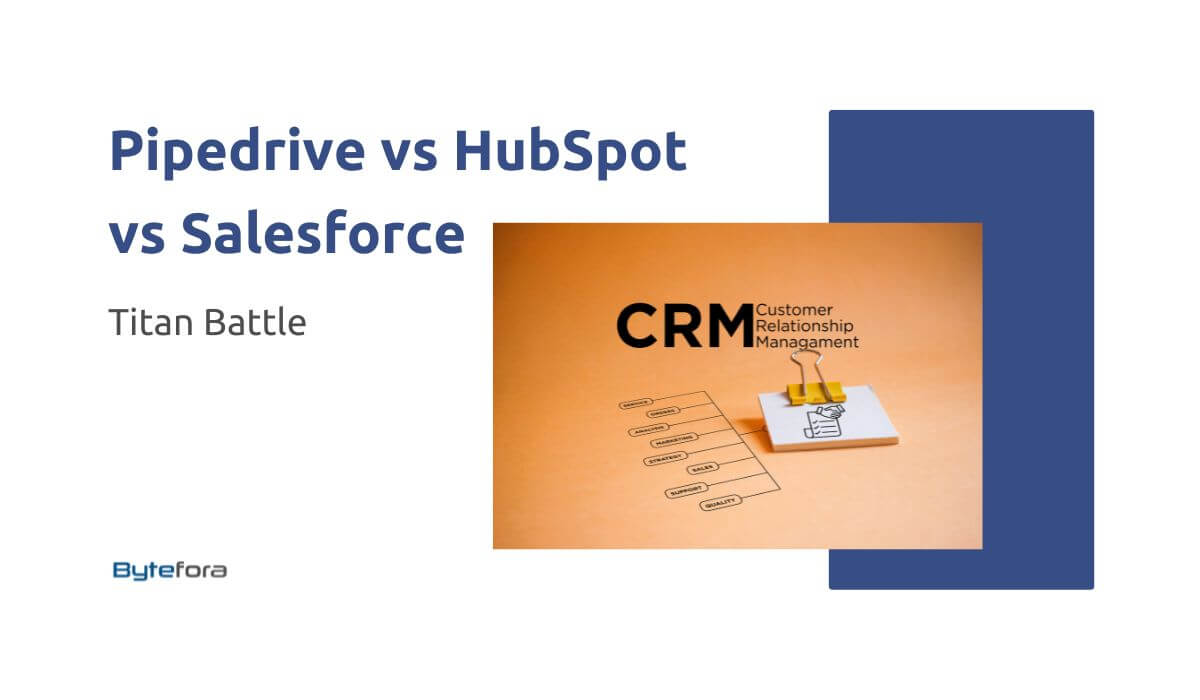Customer Relationship Management (CRM) techniques have become indispensable tools for organizations looking to streamline operations, enhance client interactions, and drive sustainable growth. Selecting the proper CRM resolution is a critical decision that can seriously impact a company’s efficiency and success. In this article, we comprehensively compare three prominent CRM platforms – Pipedrive, HubSpot, and Salesforce – to help businesses navigate the intricate process of choosing the one that aligns entirely with their unique needs.
This exploration intends to empower businesses with the knowledge to make informed decisions. Whether you are a small startup, a growing mid-sized enterprise, or an established industry giant, understanding the intricacies of Pipedrive, HubSpot, and Salesforce will enable you to tailor your CRM strategy to propel your business forward.
As we embark on this journey, we’ll dissect each CRM platform’s features, functionalities, and nuances, allowing you to discern which resonates best with your organizational requirements. From the user interface to pricing models and scalability, we aim to equip you with the insights necessary for a confident and well-informed CRM selection.
So, buckle up as we unravel the intricacies of Pipedrive, HubSpot, and Salesforce, shedding light on each CRM giant’s strengths, weaknesses, and unique offerings. This guide is designed to be your compass, navigating you through the complex terrain of CRM options and ultimately leading you to the solution that will propel your business to new heights.
Table of Contents
Understanding Your Business Needs
Before delving into the specifics of Pipedrive, HubSpot, and Salesforce, you must embark on a journey of self-discovery for your business. The success of any CRM implementation hinges on a deep understanding of your unique operational requirements. Doing so lays the groundwork for a tailored CRM strategy that seamlessly integrates with your business processes.
Start by assessing the distinctive needs of your organization. What are the pain points you aim to address with a CRM system? Identify the areas where enhanced customer relationship management could significantly impact. Whether it’s optimizing sales processes, improving customer support, or streamlining marketing efforts, clarity on your objectives is paramount.
Transitioning from this initial assessment, consider the critical meeting your business needs. For instance, does your business heavily rely on effective pipeline management? Is marketing automation a priority to nurture leads and drive conversions? Does your customer service require robust support within the CRM platform? By answering these questions, you narrow down the functionalities essential for your CRM.
Simultaneously, keep sight of the future. Aspirations. A CRM solution should evolve seamlessly with your company, accommodating increased data, users, and processes without compromising efficiency. Your CRM should not be a short-term fix but a long-term asset that propels your organization forward.
Understanding your business needs is the cornerstone for a successful CRM implementation. By clarifying your objectives, identifying key functionalities, and considering future scalability, you set the stage for a strategic and purpose-driven adoption of Pipedrive, HubSpot, or Salesforce. This proactive approach ensures that your chosen CRM meets your current needs and aligns seamlessly with your business’s future trajectory.
Pipedrive: Unveiling the Features
Now that we’ve laid the foundation by understanding the importance of selecting the right CRM and assessing your business needs let’s delve into the specifics of Pipedrive – a famous player in the CRM arena.
Overview of Pipedrive CRM
Pipedrive stands for escape for its user-friendly interface and intuitive format. Geared towards enhancing sales processes, this CRM is favored by sales teams aiming to boost efficiency and deal visibility. Its primary focus is pipeline management, providing a visual and structured approach to monitor deals from initiation to closure.
Key Features and Functionalities
Pipeline Management: Pipedrive’s strength lies in its visual pipeline, allowing users to track deals seamlessly. The drag-and-drop interface provides a clear overview of each deal stage, facilitating easy customization based on your unique sales process.
Contact and Lead Management: The CRM’s contact and lead management capabilities enable users to organize and segment their contacts effectively. With features like contact history and communication tracking, staying connected with leads and clients becomes a streamlined process.
Automation Capabilities: Pipedrive offers automation features that help eliminate manual tasks, ensuring your team can focus on high-impact activities—deal updates to save time and enhance productivity.
Reporting and Analytics: Comprehensive reporting tools provide valuable insights into your team’s performance and overall sales metrics. Identify trends, assess conversion rates, and make data-driven decisions to refine your sales strategy.
Pros and Cons of Using Pipedrive
Pros:
Intuitive user interface
Focus on sales pipeline management
Customizable to fit various sales processes
Cons:
Limited marketing automation features
It may require additional integrations for comprehensive business management.
As we unravel the features of Pipedrive, it becomes evident that its strength lies in simplifying and optimizing sales processes. For businesses seeking a CRM solution that prioritizes pipeline management and enhances the sales journey, Pipedrive emerges as a compelling option. Stay tuned as we continue our exploration, shifting our focus to HubSpot and Salesforce to provide a holistic understanding of CRM options in the market.
HubSpot: A Comprehensive Analysis
Building on our exploration of CRM solutions, let’s turn our attention to HubSpot – a versatile and widely-used platform that extends beyond traditional CRM functionalities.
Overview of HubSpot CRM
HubSpot is renowned for providing an all-encompassing. While its CRM component is free, HubSpot offers additional modules for marketing automation, sales automation, and customer service – creating an integrated ecosystem for comprehensive business management.
Key Features and Functionalities
Marketing Automation: HubSpot’s tools empower businesses to create, schedule, and analyze marketing campaigns. From email marketing to lead nurturing, these features ensure a cohesive approach to engaging leads and converting them into customers.
Sales Automation: The CRM’s sales automation capabilities streamline the sales revolution, from lead capture to deal closure. Automation features include email sequences, task assignments, and deal tracking, enabling sales teams to work more efficiently and focus on building meaningful connections.
Customer Service: HubSpot’s CRM extends beyond sales, incorporating customer service functionalities. With ticketing systems, knowledge base tools, and customer feedback features, businesses can provide exceptional support and enhance customer satisfaction.
Integration Capabilities: HubSpot offers a vast marketplace of integrations, allowing users to connect their CRM with various tools and platforms. This ensures a seamless data flow between different systems, creating a unified ecosystem for business operations.
Pros and Cons of Using HubSpot
Pros:
Integrated platform for marketing, sales, and buyer service
User-friendly interface
Robust marketing automation capabilities
Cons:
Cost increases with additional modules
The learning curve for mastering advanced features
In our comprehensive analysis, HubSpot emerges as a versatile CRM solution beyond conventional customer relationship management. Its seamless integration with marketing and customer service modules positions it as an all-in-one platform for businesses looking to consolidate their operations. Stay tuned as we progress in our exploration, shifting our focus to Salesforce to provide a holistic understanding of the CRM landscape.
Salesforce: The CRM Giant
As our exploration of CRM solutions unfolds, it’s impossible to overlook Salesforce, often hailed as the CRM giant and a pioneer in customer relationship management.
Introduction to Salesforce CRM
Salesforce is synonymous with innovation and scalability, catering to businesses of all sizes, from startups to large enterprises. Its robust and highly customizable platform offers a broad spectrum of features that extend beyond traditional CRM functionalities, making it a go-to choice for organizations seeking a comprehensive and adaptable solution.
Key Features and Functionalities
Customization Options: Salesforce is renowned for its unparalleled customization capabilities. Businesses can tailor the CRM to match their processes, industry requirements, and unique workflows. This flexibility ensures that Salesforce adapts to the company, not vice versa.
AppExchange Ecosystem: Salesforce boasts a vast marketplace known as AppExchange, offering a plethora of third-party integrations and applications. This ecosystem allows businesses to extend the functionality of their CRM, integrating it seamlessly with other tools and systems.
Salesforce Einstein AI: Artificial Intelligence (AI) is at the core of Salesforce with Einstein AI. This feature provides predictive analytics, automated insights, and intelligent recommendations, empowering sales and marketing teams to make data-driven decisions.
Enterprise-level Capabilities: Salesforce is designed to handle the complexities of enterprise-level operations. From managing large datasets to handling intricate sales processes, it provides the scalability and robustness required by organizations with extensive and dynamic needs.
Pros and Cons of Using Salesforce
Pros:
Unmatched customization capabilities
Extensive AppExchange ecosystem for integrations
Powerful AI-driven insights with Salesforce Einstein
Cons:
Higher cost, especially for advanced features
A steeper learning curve for complete mastery
In this comprehensive analysis, Salesforce emerges as the CRM giant that offers unparalleled customization and scalability. Its rich feature set, extensive AppExchange ecosystem, and cutting-edge AI capabilities make it a formidable choice for businesses seeking an enterprise-level CRM solution. As we continue our journey, the next step involves a head-to-head comparison of these CRM platforms, providing a detailed matrix to aid your decision-making process. Stay tuned for insights to help you navigate the intricate landscape of Pipedrive, HubSpot, and Salesforce.
Head-to-Head Comparison
As we progress in our quest to find the ideal CRM solution, we must compare Pipedrive, HubSpot, and Salesforce head-to-head. This detailed analysis will clearly understand how each platform stacks up in crucial aspects, aiding the decision-making process for businesses of varying sizes and needs.
Feature Comparison Matrix
User Interface and Ease of Use:
Pipedrive: Known for its simplicity, Pipedrive’s user interface is intuitive and easy to navigate. Sales teams particularly favor it for its visual pipeline and straightforward design.
HubSpot: Offers a user-friendly interface with a focus on integration across modules. The platform may have a slight understanding curve, especially when incorporating advanced features.
Salesforce: Known for its robustness, Salesforce’s interface is highly customizable but may require some training for users to navigate efficiently.
Pricing Models:
Pipedrive: Offers a straightforward pricing structure based on the number of users, with more features available in higher-tier plans.
HubSpot: Provides a free CRM with additional paid modules. Pricing can increase as users opt for more advanced functionalities.
Salesforce: Salesforce is known for its flexibility but comes with a higher cost, especially for enterprises requiring advanced features and customization.
Integration Capabilities:
Pipedrive: Integrates with various third-party tools, but the extent may vary compared to larger platforms.
HubSpot: Boasts a rich AppExchange ecosystem, offering a wide array of integrations for marketing, sales, and customer service.
Salesforce: Excels in integration capabilities through its extensive AppExchange marketplace, allowing businesses to connect seamlessly with various tools.
Scalability and Flexibility:
Pipedrive: Suited for small to medium-sized businesses focusing on sales processes. It may require additional tools for comprehensive business management.
HubSpot: Offers scalability with its modular approach, allowing businesses to add functionalities as needed.
Salesforce: Known for its enterprise-level capabilities, providing unmatched scalability and customization opportunities for businesses of all sizes.
This comparison matrix provides a snapshot of the strengths and considerations of each CRM platform. Understanding the nuances in the user interface, pricing models, integration capabilities, and scalability is crucial in aligning the CRM with your business requirements. The next phase of our exploration will delve into real-world use cases and success stories, offering practical insights into how these CRM solutions perform in diverse business environments. Stay tuned for a deeper understanding of Pipedrive, HubSpot, and Salesforce.
Making the Decision: Factors to Consider
As we navigate the intricacies of Pipedrive, HubSpot, and Salesforce, the time has come to distill our insights into actionable guidance for making an informed decision. The choice of a CRM system is pivotal for the efficiency and success of your business, and several key factors should weigh into your decision-making process.
Budget Constraints:
Consider your budget carefully. Pipedrive often appeals to smaller businesses with its straightforward pricing, while HubSpot provides a free CRM, but additional modules may increase costs. With its robust features, Salesforce comes at a higher price point, especially for advanced functionalities. Align your budget with the features that are essential for your business needs.
User Adoption and Training Requirements:
Evaluate the user-friendliness of each platform and the potential learning curve for your team. Pipedrive is praised for its simplicity, while HubSpot’s integrated modules may require some training. With its high customization, Salesforce might need more investment in training, but it offers a robust and tailored user experience.
Integration with Existing Tools and Systems:
Assess your current tech stack and the ease of integration with the CRM. Pipedrive and HubSpot offer solid integration capabilities, but Salesforce’s AppExchange ecosystem provides many options for seamless connectivity with various tools.
Industry-Specific Needs:
Consider if your industry has specific requirements that one CRM may cater to better than others. For example, Salesforce’s extensive customization options suit businesses with unique industry workflows.
By considering these factors, you align your decision with your business’s specific needs and constraints. Each CRM has its strengths, and the goal is to find the one that aligns most seamlessly with your operational requirements and growth aspirations. In the final stretch of our exploration, we’ll summarize our key findings and offer guidance on crafting a successful CRM strategy. Stay tuned for insights enabling you to embark on your CRM journey confidently.
Conclusion: Pipedrive vs HubSpot vs Salesforce
As we conclude our exploration into the realms of Pipedrive, HubSpot, and Salesforce, the path to choosing the right CRM for your business becomes more apparent. Each platform brings unique features and abilities; your decision hinges on aligning these with your organization’s specific needs and aspirations.
Recap of Key Points:
We’ve dissected the strengths of Pipedrive in streamlining sales processes, HubSpot’s versatility in integrating marketing, sales, and customer service, and Salesforce’s reputation as an industry giant with unmatched customization and scalability. The feature-rich comparison has shed light on user interfaces, pricing models, integration capabilities, and scalability.
Guidance on Making an Informed Decision:
As you navigate the intricate landscape of CRM options, consider budget constraints, user adoption, integration capabilities, and industry-specific needs. Doing so ensures that your chosen CRM aligns seamlessly with your unique business requirements.
Crafting a Successful CRM Strategy:
The journey doesn’t end with choosing a CRM. Craft a strategy that involves thorough onboarding of your selected platform. Leverage the customization options available, regardless of the chosen CRM, to tailor the system to your workflows and processes.
The key to navigating your CRM journey lies in a thorough understanding of your business needs, a comprehensive analysis of available options, and a strategic approach to implementation. Whether you opt for the simplicity of Pipedrive, the integrated approach of HubSpot, or the robust customization of Salesforce, the goal is to leverage your chosen CRM as a catalyst for growth and success.
As you embark on this journey, keep your business objectives at the forefront, and let the chosen CRM be a tool that meets your current needs and evolves with your organization. With these insights, you can make informed judgments and navigate your CRM journey toward enhanced efficiency, customer satisfaction, and overall business success.
Frequently Asked Questions (FAQ)
What sets Pipedrive apart from HubSpot and Salesforce?
Its user-friendly interface distinguishes Pipedrive and focuses on streamlining sales processes. It excels in visual pipeline management, making deal visibility and sales efficiency
Does HubSpot’s free CRM offer sufficient features for small businesses?
Yes, HubSpot’s free CRM provides robust features for small businesses, including contact and lead management, email tracking, and integration capabilities. As your business grows, other modules can be added, requiring more advanced functionalities.
How does Salesforce cater to enterprise-level needs?
Salesforce is designed with enterprise-level capabilities, offering extensive customization options, an AppExchange ecosystem for diverse integrations, and powerful AI-driven insights through Salesforce Einstein. It is suitable for large organizations with intricate processes and scalability requirements.
Can these CRMs be integrated with existing tools and systems?
All three CRMs – Pipedrive, HubSpot, and Salesforce – offer integration capabilities. Pipedrive and HubSpot provide solid integration options, while Salesforce’s AppExchange marketplace offers various third-party integrations.
What factors should businesses consider when deciding between these CRMs?
Businesses should consider budget constraints, user adoption and training requirements, integration capabilities, and industry-specific needs when deciding between Pipedrive, HubSpot, and Salesforce. Each CRM has strengths, and the choice should align with the organization’s unique requirements.



